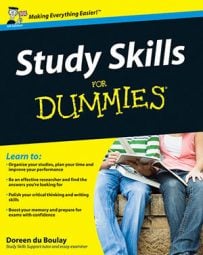While studying, you will always have a lot of reading and if you don’t keep your objectives clearly in mind, you can get sidetracked by some interesting but irrelevant information which is outside the focus of your topic. Make a note to read it later when you have more time. Searching for and finding keywords tells you that there is some potentially useful for you on the page.
Scan for keywords
A basic reading research technique is to formulate keywords – the topics, theories, names of researchers, places, methods and so on– that you want to find out about. Using a keyword search in the index of academic books tells you if they cover your topic, the number of pages devoted to the subject and which they are.
The abstracts at the beginning of journal papers contain keywords in heavy type, referring to the topic, location, methods, important institutions like the World Bank and so on, to tell you what is contained within the text.
Searching or ‘scanning’ for keywords means looking for them in the text and when you’ve found them, reading what comes before and after. The quickest way to find keywords, apart from using the index if there is one, is to look in the topic sentence of paragraphs.
Scanning can be particularly useful for finding definitions.
If you feel that your topic should be included in the work you’re reading, but you can’t find it, try another keyword that means the same thing or is linked in some way. For instance ‘gender’ if ‘feminist’ brings no results, or ‘classical economics’ if ‘Adam Smith’ brings no joy.
If you feel really perplexed that your topic is not included, then perhaps the time has come to ask ‘Why?’ This is worth checking out with your tutor. You may have found a focus for your own critique.
Skim for general information
You sometimes see expert skimmers in old-fashioned bookshops flipping through the pages of books to get a general idea of what they’re about, reading more intently when their attention is attracted.
Of course, the publisher’s blurb on a book cover can substitute for an abstract, but you, the wily reader, won’t rely on that alone because it’s written for the general public and you have individual needs, so you’ll do a bit of skimming research, particularly before paying out hard cash.
If you’re attracted by a particular book or text and want to see what it offers in general terms, then skimming can give you some clues about the type of text it is. In a book, a descriptive or scene-setting chapter may be food for thought. You may be attracted to the style and layout or use of pictorial illustration as a model, rather than the content. Skimming is a way of generally evaluating a book’s usefulness.
Really fast skimmers focus on the centre of the page and let their eyes glide down the middle of the paragraph.
All reading techniques are intended to save time (and sanity) and keep you focused. You probably do most of them already – think how you read a newspaper. You probably scan the headlines to find a subject that interests you and then maybe look at the topic of some paragraphs or skim through to get a general idea and perhaps read the introduction and conclusion carefully. You can do pretty much the same with academic texts.
When to read every word
Scanning sees keywords as more important and skimming sees all words as having limited, general value. Both these methods are speed techniques to save time and help you keep focused. They also have distinct values. However, you’re also likely to be stopped in your tracks by something potentially great. It’s a good idea to read conclusions and introductions carefully because they provide a summary of the whole piece. The following areas are generally also worthy of a bit more of your attention, where every word may count.
Definitions and potential quotations: You need to read these carefully and equally carefully note them down, including the punctuation, in order to use them in your own work. You also need to note the full reference to put in your reference or bibliography at the end, and put the author’s surname, the date and page of the publication in brackets after using the quotation in your text.
You may well want to compare definitions or quotations from different authors, so be sure to note down the references correctly as you can waste time looking for or trying to reconstruct references later on. A card index is useful for this, organised according to author or topic, as suits best.
Data and how it is presented in tables, diagrams, graphs, charts and so on: These need to be read carefully to understand how the presentation of the data encourages a certain understanding of it and whether this is deceptive or illuminating.
The steps of arguments, especially in official documents: You need to read these carefully to make sure that they’re logical and don’t make presumptions.
Writers quoting other writers: A potential source for the critical reader, especially if you’re familiar with the quotation. Read carefully to see if they’ve quoted in context or if they’ve misapplied it.
The analysis and evaluation parts of texts: Generally, originality and value lie in these parts. The rest of the text is set up to support them, though of course, can be criticised for failing to do so. These parts can be worth reading carefully to critique or gain ideas from.
Analysis and evaluation usually come in the sections (usually two) immediately before the conclusion. The conclusion will summarise them as explanations and comments on outcomes, so you can use key words in the conclusion summary to find the analysis and summary sections earlier in the text.

